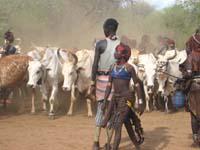Ability to drink milk in evolution
2007/01/14 Galarraga Aiestaran, Ana - Elhuyar Zientzia

Before the animals became domesticated, 9,000 years ago or more, when the child stopped sucking, he did not drink another milk, so as he matured, he lost the capacity to produce the enzyme (lactase) necessary to digest lactose.
The current population is after that time, so it is not rare to find adults without being able to digest lactose. If you drink milk, lactose cannot be digested, without discomfort. The most common symptoms are abdominal pain, winds, nausea and diarrhea, among others.
But 9.000-8,000 years ago, the man domesticated the animals. Then, milk within reach of men and women became an advantage to be able to digest this food. Therefore, evolution bets on those who could digest milk thanks to a mutation.
Area village to village

In many farming villages in Africa, milk is a staple food. (Photo: X. Source)
However, the metabolization capacity of lactose differs considerably from some population groups to others. For example, in most of Asia there has been no cattle breeding and most of its inhabitants cannot drink milk, since they have no capacity to digest lactose. On the contrary, the ancestors of northern Europe grew cattle, where very few have lactose intolerance.
In 2002, researchers identified the mutation that trains adults in Finland and the area to metabolize lactose. Mutation is in a gene related to the production of lactase. However, the researchers were surprised to see that the mutation is not so frequent among the inhabitants of southeastern Europe who drink milk, nor in the herding villages of the Middle East and Africa.
To solve the mystery, that is, to know if the tolerance to lactose has developed differently in these countries, researchers at the University of Maryland of the United States have carried out a genetic study.
They have investigated 110 people from 43 villages or groups in Kenya, Tanzania and Sudan. They have studied their DNA and measured tolerance to lactose. The result is that three other mutations have been found that allow to digest lactose.
In addition, researchers have found that one of these mutations, the most common, occurred between 3,000 and 7000 years ago. According to footprints, the cattle that domesticated in the area about 8,000 years ago and has now been shown to expand very quickly.
Therefore, it is clarified that tolerance to lactose has been developed by different ways. According to the researchers, the presence of these variants is a representative and elegant example of the influence of culture on the genome.
Proteins of milk

There is a relatively frequent allergy to the proteins of cow's milk. (Photo: Delaval)
One of these mutations causes many people to digest lactose. But even though a person has enough lactase, cow's milk can damage it. The most common cause is allergy to the proteins of cow's milk. The immune system of allergies considers harmful the proteins of cow's milk and acts against them. The derived symptoms are similar to those of lactose intolerance, so it is not rare to mix both problems.
However, most of those who can't drink milk have no problems taking dairy, so they can take advantage of the benefits of this rich food.
Published in 7K.



